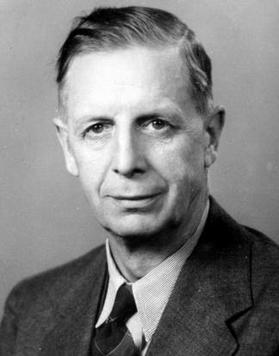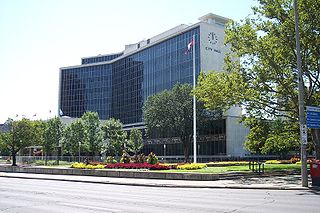
Samuel Lawrence was a Canadian politician and trade unionist.

Harry Dean Ainlay was a Canadian educator and politician, noted for his many years of service in Edmonton, Alberta, as a teacher and principal with Edmonton Public Schools and as a long time member of Edmonton City Council, including three consecutive terms as Mayor of Edmonton.
The 1945 Manitoba general election was held on October 15, 1945 to elect Members of the Legislative Assembly of the Province of Manitoba, Canada. The election was a landslide majority government for the incumbent coalition government led by the Liberal-Progressive Party.
The 1953 Winnipeg municipal election was held on October 28, 1953, to elect councillors and school trustees in the Manitoba city of Winnipeg. There was no mayoral election; mayors were elected for two-year terms in this period, and 1953 was an off year.

The 1988 Hamilton municipal election was held on November 14, 1988 to elect a Regional Chairman, a Mayor, sixteen members to Hamilton, Ontario City Council, seventeen members to the Hamilton Board of Education and thirteen members to the Hamilton-Wentworth Roman Catholic Separate School Board.

The 1985 Hamilton municipal election was held on November 12, 1985 to elect a Mayor, sixteen members to Hamilton, Ontario City Council, fourteen members to the Hamilton Board of Education and sixteen members to the Hamilton-Wentworth Roman Catholic Separate School Board. In addition, this election was accompanied by a referendum question asking voters if they wanted to directly elect individuals to the office of Regional Chairman.

Politically, Hamilton is known for producing groundbreaking, colourful and left-wing politicians. Locally, though, the big political stories have included the controversial amalgamation of Hamilton with its suburbs in 2001, the destruction of green space around the Red Hill Valley to make way for the Red Hill Creek Expressway, and plans to build a Light Rail Transit line in the city.

The 2010 Hamilton municipal election was held on October 25, 2010, to select one mayor, fifteen members of the Hamilton, Ontario City Council and members of both English and French public and Catholic school boards. Nominations opened January 4, 2010, and ran until September 10, 2010.
The 2000 Hamilton municipal election was a municipal election held on November 13, 2000, to elect municipal officials for the City of Hamilton. On election day, Hamiltonians elected a mayor, 15 city councillors, and trustees for the Hamilton-Wentworth District School Board, Hamilton-Wentworth Catholic District School Board, Conseil scolaire Viamonde, and Conseil scolaire catholique MonAvenir. This was the first election of the "New" City of Hamilton after the dissolution of the Region of Hamilton-Wentworth and the amalgamation of Dundas, Stoney Creek, Flamborough, Ancaster, Glanbrook, and Waterdown with the existing city of Hamilton.
Municipal elections were held in Toronto, Ontario, Canada, on December 7, 1953. Incumbent mayor Allan Lamport won an unexpectedly close race against school board chairman Arthur J. Brown. This election was the first for councils in the municipality of Metropolitan Toronto which would be created on January 1, 1954 and was composed of 14 municipalities: the City of Toronto, the towns of New Toronto, Mimico, Weston and Leaside; the villages of Long Branch, Swansea and Forest Hill, and the townships of Etobicoke, York, North York, East York, and Scarborough.

The 1994 Hamilton municipal election was a municipal election held on November 14, 1994, to elect municipal officials for the City of Hamilton. Hamiltonions selected one mayor, one regional chairman, and sixteen alderman to the Hamilton City Council, as well as members of both English and French Public and Catholic School Boards. Voters in the municipality also had the opportunity to cast a ballot for the Regional Chairman of the Hamilton-Wentworth region.

The 1946 Hamilton municipal election was held on December 9, 1946, to select one Mayor, four Controllers, and sixteen members of the Hamilton, Ontario City Council, as well as members of the local Board of Education. Held immediately following the 1946 Stelco strike, the election set a record for voter turnout, with 65.1% of eligible voters casting a ballot.

The 1950 Hamilton municipal election was held on December 6, 1950, to select one Mayor, four Controllers, and sixteen members of the Hamilton, Ontario City Council, as well as members of the local Board of Education. In addition, this election was accompanied by six referendums, each dealing with a major issue in the city at the time.

The 1991 Hamilton municipal election was a municipal election held on November 12, 1994, to select one Regional Chairman, one Mayor, two alderman for each of the city's eight wards for a total of sixteen members of the Hamilton, Ontario City Council, and members of both English and French Public and Catholic School Boards. This election marked one of the most stunning turnovers in local history, with four incumbent aldermen being defeated by political newcomers and Ward 3 Alderman Brian Hinkley being soundly defeated in his bid for the mayoralty against incumbent Mayor Bob Morrow.
William Kenneth Warrender was a Canadian politician, who represented Hamilton Centre in the Legislative Assembly of Ontario from 1951 to 1962 as a Progressive Conservative member. Prior to his service in the Legislature, Warrender was a lawyer and civic politician in Hamilton.

The 1932 Hamilton municipal election was held on December 5, 1932 to select one Mayor, four Controllers, and sixteen members of the Hamilton, Ontario City Council, two from each of the city's eight wards. Voters also cast ballots for trustees for the public school board.

The 1933 Hamilton municipal election was held on December 4, 1933 to select one Mayor, four Controllers, and sixteen members of the Hamilton, Ontario City Council, two from each of the city's eight wards. Voters also cast ballots for trustees for the public school board.

The 1934 Hamilton municipal election was held on December 3, 1934, to select one Mayor, four Controllers, and sixteen members of the Hamilton, Ontario City Council, two from each of the city's eight wards. Voters also cast ballots for trustees for the public school board.
The 1930 Hamilton municipal election was held on December 1, 1930 to select one Mayor, four Controllers, and sixteen members of the Hamilton, Ontario, City Council, two from each of the city's eight wards. Voters also cast ballots for trustees for the public school board.
The 1935 Hamilton municipal election was held on December 2, 1935 to select one Mayor, four Controllers, and sixteen members of the Hamilton, Ontario, City Council, two from each of the city's eight wards. Voters also cast ballots for trustees for the public school board, and in three plebiscites that sought to restructure elections for both city council and the public school board.






